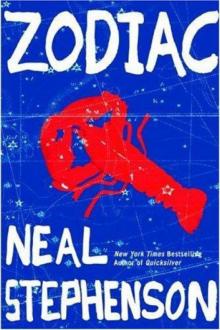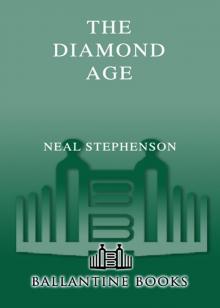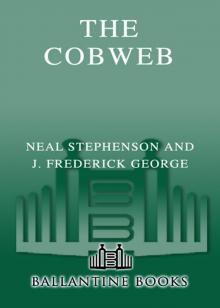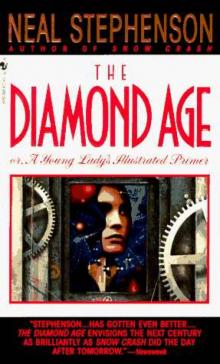- Home
- Neal Stephenson
Interface Page 6
Interface Read online
Page 6
One of the EMTs, a tiny, athletic-looking young woman with a short bristly haircut, peered down the length of the tunnel. “Does that lead somewhere?” she said. “I guess it does.”
The capitol only had three passenger elevators and they all opened directly on to the Rotunda, a yawning four-story-high well where privacy was pretty much out of the question. But buried in the wings of the building were large dumbwaiters used by house, senate, and gubernatorial staff to shuffle cartons of papers back and forth. They were easily large enough for a person, even a big person like Cozzano, to sit in.
Marsha led the EMTs through the basement, and into the storage room under the east wing where the Governor stored inactive files. Along the way they picked up Mack Crane, who was loitering in a corridor intersection, keeping a sharp eye in the direction of the stairs that led up to the first floor, looking for what Mel Meyer had referred to, alternately, as “jackals” and “witnesses.” Marsha could not help darting one glance up the stairs. She was expecting a phalanx of photographers and video crews, poised to capture her wide-eyed expression so that they could splash it up on the front page of the Trib tomorrow. But the top of the stairs was guarded by a sentry line of orange cones warning of a WET FLOOR. Bell must have done that; while no one was really afraid of a wet floor, anyone who knew the ways of the statehouse would try to avoid walking through the middle of one of Bell’s mopping projects and earning his undying enmity and noncooperation.
The dumbwaiter was stopped in the storage room, doors open.
Governor William A. Cozzano was sprawled out on the basement floor with his head and shoulders cradled in the lap of the janitor who was talking to him softly. Bell did not look up as the gurney approached. He said something to Cozzano, something about “medevac.” He slipped one arm under Cozzano’s shoulders and one under his knees and picked the two-hundred-fifty-pound Governor up as if he were a six-year-old.
“Just leave him there,” one of the EMTs said, but Bell stepped forward and gently laid Cozzano out full length on the gurney, ready for transport.
The EMTs worked over Cozzano for a few minutes. Then they rolled him out into the corridor and back toward the civil defense tunnel. Marsha glanced up the stairs as they went by and saw the knees and feet of a nocturnal journalist heading for the first-floor men’s room.
The gubernatorial stretcher, with its motorcade - the EMTs, the secretary, the cop, and the janitor - moved quickly and silently through the basement, down the tunnel, and into the basement of the building that Marsha had glimpsed earlier. No one said anything except for Cozzano, who said, jovially. “Why is everyone so wallpapered?”
The janitor in the other building was holding the freight elevator for them. They all rode it up to the ground floor, along a short hallway, and out through a roll-up steel door and into a parking lot where an ambulance was waiting. The cold air of the January night came through Marsha’s blouse as if she were naked. She pirouetted slowly, looking around, trying to establish her bearings.
The ambulance had backed into a three-sided nook that opened out on to an empty gravel parking lot covered with gray hard-packed snow. They were in back of a one-story building of rough-hewn limestone. This building had a notch taken out of its corner, and the back wall of that notch contained the roll-up door. The building was separated by a gap of just a few feet from a much larger seven-or eight-story building whose solid, windowless back wall formed the third side of the nook.
The big building was the Illinois State Armory, which also housed the Illinois State Police. The small building from which they’d just exited was the Emergency Services and Disaster Agency, its roof studded with funny-looking antennas. Marsha, who’d been working in the capitol for twenty years, was astonished to realize these things: that the Governor of Illinois had a secret escape route, a vestige of the Cold War, a secret bolt-hole to escape from atomic attack and deliver himself into the protection of the Illinois National Guard.
She wondered how many other secrets about the capitol and the office of the Governor, and about this Governor himself, she had never learned or even suspected. She wondered why she’d never been told about these things. And she wondered how Mel Meyer had known. For Marsha the acquisition of knowledge had always been an orderly process pursued in public schools, but Mel was different, Mel came by his knowledge in mysterious ways. He didn’t even have a government job, he was just the Governor’s lawyer and friend, he hardly ever came to Springfield, and still he carried all the secret blueprints and phone numbers in his head.
As the EMTs were pulling the doors of the ambulance closed on Cozzano, she saw Bell standing there, staring at Cozzano through the rear windows. As the driver shifted the transmission into forward gear, the ambulance’s backup lights flashed once like heat lightning and illuminated Bell’s face, burning the still image into Marsha’s retinas. Bell’s forehead was wrinkled in the middle, his eyebrows angled upward in the center, his eyes were glistening and red. As the engine revved, he suddenly straightened up, clicked the heels of his boots together, and snapped out a salute.
Cozzano was staring back at Bell through the tiny windows in the back of the ambulance. The Governor moved his right arm, heavy with blood-pressure cuff and intravenous lines, and returned the salute. The ambulance moved forward on twin jets of steamy exhaust and angled across the parking lot, headed for the trauma center at Springfield Central Hospital, less than a mile away.
6
As soon as Dr. Mary Catherine Cozzano got on the down elevator, headed for the parking garage, she began to go through a ritual she had developed for passage through hostile territory. She hauled the strap of her purse up over her head so that it ran diagonally across her body, snatch-proof. It hung on her right hip so as not to interfere with her pager, which was clipped to her left hip. She unzipped the purse, pulled out her key chain, and clenched it in her right fist so that the keys stuck out from between her fingers like spikes on a medieval weapon. As she carried her keys in her purse, she observed no size limitations; her key chain was as sprawling and ramified as a coronary artery, branching out to include a miniature Swiss Army knife, a penlight, a magnifying glass (all freebies from drug companies), and a stainless steel police whistle. The whistle dangled on a thick length of metal rope. She got it between her thumb and index finger, ready to use. She had already made sure that she was wearing her running shoes - not high heels, not boots - and a pair of scrub pants that offered her legs freedom of movement. That was a given, because these were the only clothes anyone could tolerate on a thirty-hour shift in a sprawling hospital.
Finally, as the elevator was passing downward through the lobby level and into the subterranean parking levels, she reached into her purse and pulled out a black box that fit neatly into her left hand. It was rectangular with a bend near one end. The bent end was concave and sprouted four blunt metal prongs about a quarter of an inch long, making it look like the mouthparts of a tremendously magnified chigger. The prongs were symmetrically arranged: an
outer pair that stuck straight out from the end of the device, and an inner pair, closer together, angled toward each other as they sprouted from the concavity. When Mary Catherine found the box inside her purse, it fell naturally into her hand in such a way that her index finger was resting on a black button, just under the crook, near the prongs. Mary Catherine pulled it out of her purse, held it away from herself, and pulled the trigger.
A miniature lightning bolt, a purplish-white line of electrical discharge, popped between the two inner prongs. It created an alarming, crusty buzzing noise that seemed to penetrate deep into her head. The spark whipped and snapped in the air like a slack clothesline caught in a November wind.
She tested it like this, every day, because she was William A. Cozzano’s daughter, and because her father was John Cozzano’s son, and everyone in their family learned, when they were very young, not to be sloppy, not to assume, not to take anything for granted.
Then the elevator doors o
pened, like the opening curtain on a cheap horror film, and she was staring into a low-ceilinged catacomb, filled with greenish, inexpensive institutional light that was hard on the eyes but did not really seem to illuminate anything. These were the tombs where doctors and nurses buried their cars while they worked. Most of the cars were shambling zombies, long since turned undead by the depredations of mobile chop shops that cruised up and down the ramps night and day.
During these trips through the catacombs, Mary Catherine liked to tell herself that her chosen speciality gave her an advantage in self-defense: she could diagnose people from a distance. By the way they walked, by the reactions on their faces, she could tell active psychotics from healthy, run-of-the-mill radio thieves.
Mary Catherine was not the kind of woman who would carry a weapon in her purse. She was not sure what kind of woman would, but certainly not her. She did it anyway. At first it had been a concession to her father. Ever since the death of her mother, her father’s concern for her safety had become an obsession with him. When she had moved into her apartment, he drove up from Tuscola with all of his tools and spent a weekend reinforcing the deadbolts, putting bars on the windows, caging her in from the outside world. The people who lived in the apartment across the air shaft - an extended family of Brazilian immigrants - spent most of that weekend gathered in the living room, almost as if for a family portrait, staring in astonishment as the Governor of Illinois dangled halfway out of a sixth-story window sinking bolt hole after bolt hole into the brick window frames with a massive three-quarter-inch electric drill that he had borrowed from one of his farmer cousins.
The next time her birthday rolled around, Dad had given her a small, neatly wrapped box. Mary Catherine had been embarrassed and flushed with gratitude, thinking it was a necklace - and coming from Dad, it was sure to be too formidable to wear. But when she had gotten it out of the box, it turned out to be a stun gun instead. A fitting weapon for a neurologist.
Dad had never observed any limitations on his life. He saw nothing remarkable in assuming that one day he would be President of the United States. He had always assumed that Mary Catherine would feel the same way. He always told her that she could do anything she wanted with her life, and while she never doubted him, she always took it with a grain of salt. And when he first became aware that, as a woman, she was in danger in ways that he was not, and that this danger limited what she could do, he was deeply troubled. He refused to accept it for a long time. But he was starting to understand and was trying to find ways to exempt her from the regulations that society imposed on all women. Because, goddamn it (she could hear him say), it just wasn’t fair. Which was all the reason he needed to do anything.
She was halfway to her car when her beeper detonated, scaring her half out of her scrubs. She had been awake or virtually awake for thirty-six hours and was running on a lean, rancid bland of caffeine and adrenaline. One reflex told her to grab the beeper and push the button that would make it shut up. The other reflex told her to pull the trigger on her stun gun and get it up into the solar plexus of any bad guys who might be in her vicinity. The reflexes got a little confused and the two little black boxes collided, the stun gun and the beeper, and the stun gun won; the beeper went silent.
(a) This was no time to stand still and figure out the problem and (b) as of thirty minutes ago, she was no longer on call. This had been a mistake on the part of the operator. She had paged the wrong doctor. Sooner or later, they would figure it out, they always did. Right now, Dr. Cozzano needed to get home and sleep.
When she got back to her apartment, her answering machine was taking down a message from a man whose voice she did not recognize. She just caught the tail end of it as she was coming through the door: “… condition is stable and he’s under the personal care of Dr. Sipes, who of course is a very fine neurologist, Thanks. Bye.”
She recognized the name Sipes; he was on the faculty of the Central Illinois University College of Medicine and he showed up at all the conferences. Apparently this call had come from downstate, where some colleague had a question about something. Didn’t sound urgent; she would call him back later. She turned down the volume on the answering machine, locked all of the locks that Dad had installed to keep her safe, fed the cat, and went into the bathroom.
There was a mirror in the bathroom. Mary Catherine had not looked in a mirror for something like a day and a half. She took this opportunity to see if she still recognized herself.
Her father was the Governor of Illinois, which meant that this face of hers showed up on television and in the newspapers with some regularity. She had to look respectable without being dowdy. She was also a doctor, so she had to look smart and professional. She was a resident, so she had no money and couldn’t spend any time at all worrying about how she looked. And she was the product of a small town in Illinois and had to go back there every couple of weeks and not seem uppity and strange to her old Girl Scout chums.
Once you left the city limits of Chicago you were in Big Hair Territory. Mary Catherine had been the only girl in her high school who had escaped the syndrome. She had extremely thick, black, luxuriant Italian hair with a natural wave that, during the humid summers, turned into a curl. She would have preferred to shave her head for the duration of the residency. Dad was never happy unless she let it grow down to her waist. In compromise, she had settled on a cut that let it hang just above her shoulders.
She showered and climbed into bed with wet hair. A few bits of mail had arrived, notes and cards from friends and family members in other parts of the country, and she leafed through them by her bedside lamp. Her eyes could not trace the handwriting, and the contents penetrated her brain only feebly. It was a waste of time. She reached to turn off the ringer on her telephone, but discovered that it was already turned off. She had probably turned it off the last time she had attempted to get some sleep, whenever that was. The time was 9:15 p.m. She set her three alarm clocks for five o’clock in the morning. She tossed the pager and the stun gun on to her bedside table. The pager no longer responded when she pushed the TEST button. Apparently the stun gun had fried its microchips.
When she woke up, the bedside clocks all read within a few minutes of 9:45 and someone was pounding rhythmically on her front door with a heavy object. For a moment she thought she had overslept and that it was 9:45 in the morning, but then she realized that it was dark outside and her hair was still wet.
It sounded like someone was trying to break in with a sledgehammer. She pulled on jeans and an ILLINI sweatshirt, went to the door, and peered out through the peephole.
It was a cop. The wide-angle view in the peephole made his body very large and his head very small, amplifying his already cop-like appearance. He had a hug L-shaped billy club in one hand and was patiently ramming the butt of it into her door. Standing behind the cop was a man in a trench coat with his hands in his pockets. He was shorter than the cop, so that the peephole magnified his face rather than his body. It was Mel Meyer.
“Okay!” she shouted. “I’m up.” She sounded cheerful and ready for anything, even though she was neither. Women of the prairie did not bitch, nag, or whine.
Then she thought: Why is Mel here?
Dad had as many lawyers as a mechanic had wrenches. He embodied a large business, a fortune, a few charities, and the state of Illinois, and lawyers came with all of those things. They were always around. Always calling Dad, taking him to dinner, coming over to his house with papers to sign. Sometimes she couldn’t tell which were his friends, which were his business associates, and which were actually representing him. To Mary Catherine, lawyers had always seemed as common as air, the taxi drivers, bag boys, and janitors of the world of affairs.
But if all those other lawyers were William A. Cozzano’s army, then Mel Meyer was the stiletto strapped to his ankle. Mel was the eschatological counselor of the Cozzano clan, drafter of wills, executor of estates, godfather of children, and if the whole world turned to decadenc
e and strife one day and civilization collapsed, and Dad were trapped on a hilltop surrounded by the heathen, Mel would shoot himself in the head so that Dad could use his corpse as a rampart. He was small, bald, rumply, tired-looking, lizard-eyed, and didn’t talk much, because he was always thinking everything out two hundred years into the future.
And now he was standing in her hallway, with a cop, quiet and motionless as a fire hydrant, hands in the pockets of his trench coat, staring at the wallpaper, thinking.
She undid the locks and opened the door. The cop stepped aside, clearing a wide space between Mel and Mary Catherine. “Your pa needs you,” Mel said. “I got a chopper. Let’s go.”
Springfield Central had started out as your basic Big Old Brick Hospital with a central tower flanked symmetrically by two slightly shorter wings. Half a dozen newer wings, pavilions, sky bridges, and parking ramps had been plugged into it since then, so that looking at it from the window of the chopper, Mary Catherine could see it was the kind of hospital where you spent all your time wandering around lost. The roofs were mostly flat tar and pea-gravel, totally dark at this time of night, though in areas that were perpetually shaded, patches of snow glowed faintly blue under the starlight. But the roof of one of the old, original wings was a patch of high noon in the sea of midnight. It bore a red square with a white Swiss cross, a red letter H in the center of the cross, and some white block numerals up in one corner. Well off to the side, new doors - electrically powered slabs of glass - had been cut into the side of the old building’s central tower.
It made her uneasy. This wasn’t Dad’s style. As the governor of one of the biggest states in the union, William A. Cozzano could have lived like a sultan. But he didn’t. He drove his own car and he did his own oil changes, lying flat on his back in the driveway of their house in Tuscola in the middle of the winter while frostbitten media crews photographed him in the act.

 Zodiac: The Eco-Thriller
Zodiac: The Eco-Thriller The Mongoliad: Book One
The Mongoliad: Book One Snow Crash
Snow Crash The Confusion: Volume Two of the Baroque Cycle
The Confusion: Volume Two of the Baroque Cycle The Rise and Fall of D.O.D.O.
The Rise and Fall of D.O.D.O. The Diamond Age: Or, a Young Lady's Illustrated Primer
The Diamond Age: Or, a Young Lady's Illustrated Primer The Big U
The Big U The System of the World: Volume Three of the Baroque Cycle
The System of the World: Volume Three of the Baroque Cycle The Cobweb
The Cobweb Reamde
Reamde Fall; or, Dodge in Hell
Fall; or, Dodge in Hell Interface
Interface Quicksilver
Quicksilver The Mongoliad: Book Three
The Mongoliad: Book Three Seveneves
Seveneves Atmosphæra Incognita
Atmosphæra Incognita In the Beginning...Was the Command Line
In the Beginning...Was the Command Line Anathem
Anathem The Rise and Fall of D.O.D.O.: A Novel
The Rise and Fall of D.O.D.O.: A Novel The Mongoliad: Book Two
The Mongoliad: Book Two Diamond Age or a Young Lady's Illustrated Primer
Diamond Age or a Young Lady's Illustrated Primer THE System OF THE WORLD
THE System OF THE WORLD The Mongoliad: Book One tfs-1
The Mongoliad: Book One tfs-1 Some Remarks: Essays and Other Writing
Some Remarks: Essays and Other Writing Zodiac
Zodiac Spew
Spew The Baroque Cycle: Quicksilver, the Confusion, and the System of the World
The Baroque Cycle: Quicksilver, the Confusion, and the System of the World The Diamond Age
The Diamond Age Reamde: A Novel
Reamde: A Novel In the Kingdom of Mao Bell
In the Kingdom of Mao Bell Mother Earth Mother Board
Mother Earth Mother Board Twelve Tomorrows - Visionary stories of the near future inspired by today's technologies
Twelve Tomorrows - Visionary stories of the near future inspired by today's technologies The Confusion
The Confusion The Great Simoleon Caper
The Great Simoleon Caper The Mongoliad: Book Three tfs-3
The Mongoliad: Book Three tfs-3